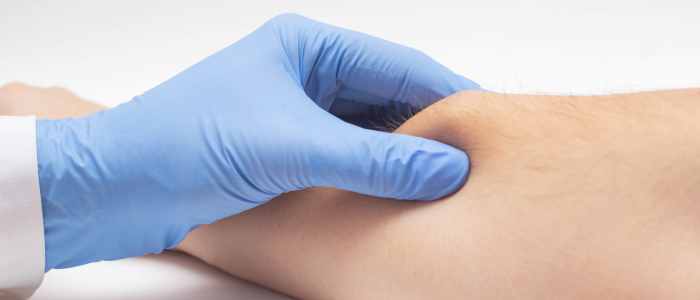
Table of Contents
- What to Expect during Recovery after Lipoma Removal
- What to Expect on the Day of Lipoma Removal Surgery
- Morning Preparations
- Arrival at the Surgical Facility
- Meeting Your Surgical Team
- The Surgery
- Post-Surgery Instructions
- Setting the Stage for Recovery
- Dos and Don’ts during the First Week after Lipoma Removal
- Dos:
- Don’ts:
- Complications That Can Occur During Recovery after Lipoma Removal
- Infection
- Seroma
- Haematoma
- Scarring
- Numbness or Changes in Sensation
- Recurrence of the Lipoma
- Allergic Reactions
- Anca’s Recommendations for a Speedy Recovery after Lipoma Surgery
- 1. Prioritise Rest, but Stay Gently Active
- 2. Optimise Your Nutrition
- 3. Stay Hydrated
- 4. Manage Pain and Discomfort Wisely
- 5. Care for Your Incision
- 6. Monitor for Any Signs of Complications
- FAQs about Lipoma Removal
- Further Reading about Skin Procedures at Cheshire Cosmetic Surgery
What to Expect during Recovery after Lipoma Removal
Lipomas, those benign lumps of fat that nestle beneath our skin, are more than just a physical annoyance for many. While typically harmless, their presence can cause discomfort, concern, and sometimes, pain, leading many to opt for removal.
In this blog, Consultant Plastic Surgeon Anca Breahna will discuss the lipoma removal process and recovery, providing a clear roadmap of what to expect before, during, and after the procedure.
What to Expect on the Day of Lipoma Removal Surgery
The day of your lipoma removal surgery can be a source of anxiety and anticipation. Knowing what lies ahead can help alleviate concerns and prepare you for a smooth surgical experience. Here’s a step-by-step guide on what to expect:
Morning Preparations
- Fasting: Depending on the type of anaesthesia to be used, you may be advised to fast for a certain period before your surgery. This is from midnight the night before
- Personal Care: Shower using antibacterial soap, as recommended, to minimise the risk of infection. Avoid applying lotions, perfumes, or deodorants
- Clothing: Wear loose, comfortable clothing that can be easily removed and won’t press against the surgical site post-operation
Arrival at the Surgical Facility
- Check-in: Upon arrival, you’ll check in and complete any necessary paperwork. This is a good time to ask any last-minute questions you might have
- Pre-Surgical Assessment: A nurse will conduct a pre-surgical assessment, which may include checking your vital signs, reviewing your medical history, and confirming the lipoma’s location
Meeting Your Surgical Team
- Anaesthesiologist Consultation: If general anaesthesia or sedation is to be used, the anaesthesiologist will discuss how it will be administered and what to expect
- Surgeon Consultation: Anca may mark the area to be operated on and go over the procedure again, ensuring you understand and consent to the planned removal
The Surgery
- Anaesthesia: The type of anaesthesia administered will depend on the size of the lipoma and its location. Local anaesthesia is commonly used for small lipomas, allowing you to be awake but pain-free
- The Removal Process: Anca will make an incision over the lipoma, carefully excise it, and then close the incision with sutures. The procedure usually takes less than an hour
- Recovery Room: After the surgery, you’ll be moved to a recovery room where nurses will monitor your vital signs as the anaesthesia wears off
Post-Surgery Instructions
- Immediate Aftercare: You’ll receive instructions on how to care for the incision, signs of infection to watch for, and pain management
- Discharge: Most lipoma removals are outpatient procedures, meaning you can go home the same day. Ensure you have someone to drive you home, as you may still be groggy from the anaesthesia
Setting the Stage for Recovery
- Rest: Once home, rest is paramount. Though you may feel fine, allowing your body to heal is crucial for a smooth recovery
- Follow-Up: Pay attention to any scheduled follow-up appointments to have sutures removed or to check on the healing process
Dos and Don’ts during the First Week after Lipoma Removal
The first week after lipoma removal is a critical period for your recovery. Proper care and adherence to Anca’s instructions can significantly impact your healing process, comfort levels, and the final outcome of the surgery. Here are some dos and don’ts for the first week of recovery after lipoma removal:
Dos:
- Follow Anca’s Aftercare Instructions: Adherence to the aftercare guidelines provided by your surgeon is important. These instructions are tailored to your specific situation and are designed to ensure optimal healing
- Keep the Surgical Site Clean and Dry: Maintaining the cleanliness of the incision site is crucial to prevent infection. Follow Anca’s advice on how to care for the wound, including when and how to change the dressing
- Take Prescribed Medications as Directed: If you’ve been prescribed antibiotics to prevent infection or pain medication to manage discomfort, take them exactly as directed. Do not stop antibiotics prematurely, and use pain relief as needed
- Rest and Elevate: Ensure you get plenty of rest. If your lipoma was removed from an extremity, keep it elevated as much as possible to reduce swelling and promote healing
- Stay Hydrated and Eat Nutritious Foods: Hydration and nutrition play a crucial role in recovery. Drink plenty of water and eat a balanced diet rich in vitamins and minerals to support the body’s healing process
- Attend Follow-Up Appointments: These appointments allow Anca to monitor your healing progress, remove sutures if necessary, and address any concerns you may have
Don’ts:
- Don’t Submerge the Wound: Avoid baths, swimming pools, or any activity that could submerge the incision site in water until your surgeon gives the all-clear. Showering is usually allowed, but direct water flow on the wound should be avoided
- Avoid Strenuous Activities and Heavy Lifting: Physical exertion can put stress on the healing incision, potentially causing it to reopen or delay healing. Avoid heavy lifting and strenuous activities until your surgeon advises it’s safe to resume them
- Don’t Ignore Signs of Infection: Be vigilant for signs of infection, such as increased redness, swelling, warmth, or pus at the incision site, as well as fever. If you notice any of these signs, contact Anca’s team immediately
- Don’t Skip Pain Management: Managing your pain is important for your recovery. Skipping pain medication can make it difficult to move or rest comfortably, which is essential for healing
- Don’t Smoke: Smoking can significantly impede your healing process by reducing blood flow and oxygen to the wound site. If possible, avoid smoking before and after your surgery to facilitate better healing
- Don’t Rush the Recovery Process: Everyone’s body heals at its own pace. Don’t rush your recovery or become discouraged if healing seems slower than expected
Following these dos and don’ts during the first week after lipoma removal surgery can help ensure a smooth and successful recovery. It’s important to remember that this period sets the foundation for the healing process.
Complications That Can Occur During Recovery after Lipoma Removal
While lipoma removal is a safe and straightforward procedure, as with any surgical intervention, there are potential complications that can occur during the recovery period. Awareness and early detection of these issues can help mitigate their impact and prevent more serious complications:
Infection
Infection is one of the most common complications following any surgery. Signs include redness, swelling, warmth at the incision site, discharge, and fever. Preventive measures include proper wound care and taking prescribed antibiotics as directed. If you suspect an infection, it’s crucial to contact Anca’s team promptly.
Seroma
A seroma is a pocket of clear fluid that sometimes accumulates under the skin near the surgical site. While seromas often resolve on their own, they may require drainage if they become large or uncomfortable.
Haematoma
A haematoma is a collection of blood outside of blood vessels, which can occur if a blood vessel is damaged during surgery. Small haematomas may resolve on their own, but larger ones might need to be drained to prevent pressure and discomfort.
Scarring
Scarring is an inevitable part of the healing process after any surgical incision. The appearance of scars can vary widely among individuals. Discuss scar management techniques with Anca, including the use of silicone sheets or gels and massage once the wound has healed.
Numbness or Changes in Sensation
Temporary numbness or changes in sensation around the incision site are possible due to nerve damage or disruption during surgery. These sensations usually improve over time but can be permanent in rare cases.
Recurrence of the Lipoma
Although rare, there is a possibility that a lipoma may recur in the same location, especially if the removal was incomplete. Regular follow-up appointments can help detect any recurrence early.
Allergic Reactions
Allergic reactions to sutures, dressings, or prescribed medications can occur. Symptoms may include rash, itching, or swelling. If you experience any signs of an allergic reaction, contact your healthcare provider.
Being aware of these potential complications and knowing what signs to look for can help you take proactive steps should any issues arise.
Anca’s Recommendations for a Speedy Recovery after Lipoma Surgery
Recovering from lipoma removal surgery can be a straightforward process with the right care and precautions. Based on a combination of clinical best practices and patient experiences, here are Anca’s top recommendations to facilitate a speedy and smooth recovery after lipoma removal surgery:
1. Prioritise Rest, but Stay Gently Active
While rest is crucial in the days following your surgery, incorporating gentle activities can aid in your recovery. Light walking around your home or neighbourhood can help prevent blood clots and maintain circulation. However, listen to your body and avoid overexertion; your main priority should be healing.
2. Optimise Your Nutrition
Your body requires a wealth of nutrients to heal effectively. Focus on a balanced diet rich in proteins, vitamins, and minerals. Proteins are the building blocks for tissue repair, so include lean meats, beans, and tofu in your diet. Fruits and vegetables loaded with vitamins C and A, such as oranges, strawberries, spinach, and carrots, can help with wound healing and immune function.
3. Stay Hydrated
Adequate hydration is essential for optimal recovery. Water plays a key role in healing by transporting nutrients to the wound site and flushing out toxins from your body. Aim for at least 8-10 glasses of water daily, and consider incorporating hydrating foods like cucumbers, zucchini, and watermelon into your diet.
4. Manage Pain and Discomfort Wisely
Adhere to your prescribed pain management plan, but also explore additional comfort measures. For instance, applying ice packs to the surrounding area (not directly on the incision) can reduce swelling and provide relief. Always wrap ice packs in a cloth to avoid skin damage and limit application to 20 minutes at a time.
5. Care for Your Incision
Proper incision care is important to prevent infection and promote healing. Keep the area clean and dry, and follow your surgeon’s instructions for dressing changes. Avoid using any lotions or creams on the incision site unless approved by Anca.
6. Monitor for Any Signs of Complications
Early detection of complications such as infection or seroma can significantly impact your recovery. Regularly inspect your incision for signs of infection, including increased redness, warmth, swelling, or discharge. If you notice any concerning symptoms, don’t hesitate to contact Anca’s team.
FAQs about Lipoma Removal

What is the recovery time for a lipoma removal?
The recovery time for lipoma removal varies depending on the size and location of the lipoma, as well as the individual’s overall health. Most patients can return to their normal daily activities within a few days to a week after the procedure. Keep in mind that complete healing of the surgical site and the resolution of any bruising or swelling may take up to a few weeks. It’s important to follow Anca’s specific post-operative instructions to ensure a smooth recovery.
What can you not do after lipoma surgery?
After lipoma surgery, it’s important to avoid strenuous activities, heavy lifting, and any form of exercise that could strain the incision site for at least the first two weeks or until Anca advises it’s safe. Submerging the surgical site in water, such as bathing or swimming, should also be avoided until the wound has fully healed and Anca gives the go-ahead. Additionally, avoid smoking and consuming alcohol as these can impair wound healing and increase the risk of complications.
What are the side effects of lipoma removal?
Side effects of lipoma removal are generally minimal but can include pain, swelling, bruising, and temporary numbness around the surgical site. There’s also a risk of infection, haematoma, or seroma formation, although these are less common. Scarring is an inevitable side effect, but the severity depends on the size of the incision and the individual’s healing process. Discussing aftercare with Anca can help minimise these side effects.
Is excision of lipoma a major surgery?
Excision of a lipoma is considered a minor surgical procedure, especially when the lipoma is small to medium in size and located in an easily accessible area under the skin. The surgery is usually performed on an outpatient basis under local anaesthesia, meaning patients can go home the same day. Removal of larger lipomas or those situated in more complex locations may require a more involved surgical approach.
How long after lipoma surgery can I exercise?
The timeline for resuming exercise after lipoma surgery depends on the extent of the procedure and Anca’s advice. Generally, light activities such as walking can be resumed within a few days post-surgery to promote circulation. More strenuous activities, including lifting weights and high-impact exercises, should be avoided for at least 2-4 weeks or until Anca confirms that the incision has healed sufficiently to withstand the physical stress.
What will my scar look like after lipoma removal?
The appearance of your scar after lipoma removal will depend on several factors, including the size of the lipoma, the location, the technique used for removal, and your body’s healing response. Initially, the scar may appear red and slightly raised but should gradually fade and flatten over time, becoming less noticeable. Proper wound care, including keeping the area clean and protected from the sun, along with following Anca’s guidance on scar management techniques, can help minimise the appearance of the scar.
Medical References about Lipoma Removal
- Lipoma – Diagnosis & treatment – Mayo Clinic
- Lipoma: What Is It, Causes, Symptoms, Types, Treatment – Cleveland Clinic
- Lipoma – NHS
- Lipoma: Causes, symptoms, diagnosis, and removal – Medical News Today
- Lipoma (Fatty Tumor): Causes, Symptoms, Diagnosis – WebMD
Further Reading about Skin Procedures at Cheshire Cosmetic Surgery
- Read more about Recovery after Cyst Removal
- Read more about Why you should see a Plastic Surgeon for Minor Skin Surgery, Lumps and Bumps







